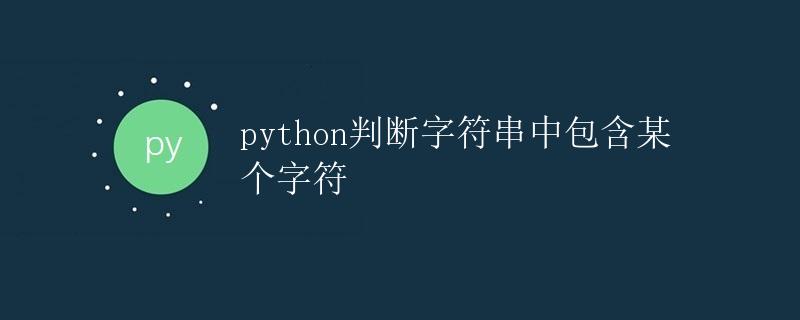Python判断字符串中包含某个字符

在日常编程中,经常会遇到需要判断一个字符串中是否包含特定字符的情况。Python提供了多种方法来实现这一功能,本文将介绍几种常用的方法,并给出相应的示例代码。
方法一:使用in关键字
Python中的in关键字可以用来判断一个字符串是否包含另一个字符串或字符。具体用法如下:
str1 = "Hello, World!"
char = "o"
if char in str1:
print(f"The character '{char}' is in the string.")
else:
print(f"The character '{char}' is not in the string.")
运行结果:
The character 'o' is in the string.
方法二:使用count()方法
Python的字符串对象还提供了count()方法,该方法可以统计特定字符在字符串中出现的次数。如果特定字符出现次数大于等于1,则说明字符存在于字符串中,否则不存在。具体用法如下:
str2 = "Python is awesome!"
char = "z"
if str2.count(char) >= 1:
print(f"The character '{char}' is in the string.")
else:
print(f"The character '{char}' is not in the string.")
运行结果:
The character 'z' is not in the string.
方法三:使用find()方法
Python的字符串对象还提供了find()方法,该方法可以找到特定字符在字符串中的位置,如果找到则返回对应位置的索引,未找到则返回-1。利用这一特性,我们可以判断特定字符是否存在于字符串中。具体用法如下:
str3 = "I love Python!"
char = "P"
if str3.find(char) != -1:
print(f"The character '{char}' is in the string.")
else:
print(f"The character '{char}' is not in the string.")
运行结果:
The character 'P' is in the string.
方法四:使用正则表达式
如果需要更加灵活地匹配字符串中的字符,可以使用正则表达式。re模块提供了强大的正则表达式操作,可以满足各种复杂的需求。具体用法如下:
import re
str4 = "Welcome to Python!"
char = "w"
pattern = re.compile(char, re.IGNORECASE)
if pattern.search(str4):
print(f"The character '{char}' is in the string.")
else:
print(f"The character '{char}' is not in the string.")
运行结果:
The character 'w' is in the string.
通过以上方法,我们可以轻松地判断一个字符串中是否包含特定字符。根据实际需求和复杂度,选择合适的方法进行判断,提高代码效率和可读性。
 极客教程
极客教程